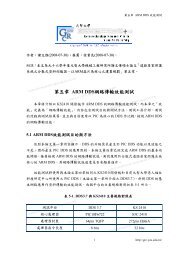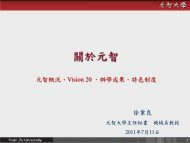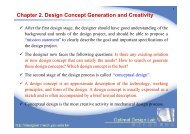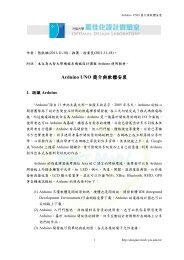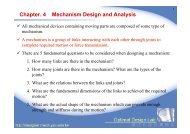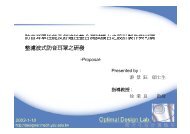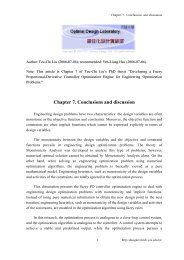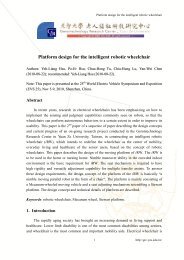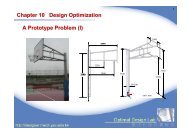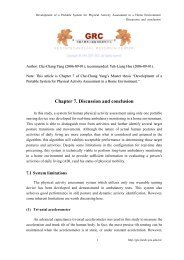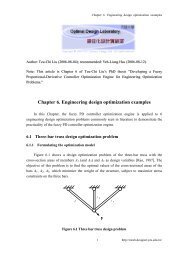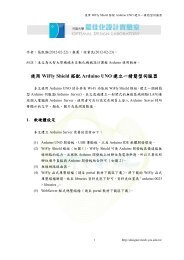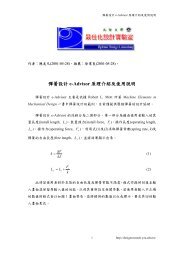PDF Version
PDF Version
PDF Version
Create successful ePaper yourself
Turn your PDF publications into a flip-book with our unique Google optimized e-Paper software.
110 Yung-Chieh Hung and Yeh-Liang Hsu‘contradiction solving’ [4]. The ideality of a system isthe measure of how close it is to the perfect system.The perfect system has all the expected benefits tothe customer with no cost and harmful effects. Theapplication of the concept of ideality can reducethe number of elements in the system to lowerproduct cost and enhance product benefits. Meanwhile,designing around the existing patents aimsto reduce the elements that constitute the claims orto replace the existing elements with different onessharing the same idea of ideality.However, when a design engineer tries to reducethe elements that constitute the claims or to replacethe existing elements with different ones, a systemincompatibility or conflict design problem is usuallycreated. That is, as the designer changes certainparameters of the system in a given design problem,this might adversely affect other parameters. In TRIZ,these are called ‘trade-off contradictions’. The‘trade-off’ means that the design engineer ‘trades’the improvement of one feature against deteriorationof another feature in the hope of finding a compromisesolution to the problem.In TRIZ, the concept of ‘contradiction solving’,which seeks to identify and eliminate contradictions,is almost the complete opposite of traditionalproblem-solving strategies, in which the emphasisis very firmly placed on the importance of achieving‘optimum’ compromises between the conflictingproblem parameters. If the conflicting componentsinvolve ‘inherent contradiction’ or ‘physical contradictions’,separation of action, space, or time isrecommended. If the contradictions are trade-offcontradictions, TRIZ introduces 40 principles witha contradiction matrix to solve about 1500 problemsinvolving technical contradictions.The present paper proposes an integrated processfor designing around existing patents through TRIZ.This process integrates patent design-around strategies,innovative design methods in TRIZ, and rules ofpatent infringement judgement systematically todesign around existing patents and increase thepatentability of results of innovation.Figure 1 shows the flow chart of this integratedprocess. To start with, the designer conducts standardpatent search and analysis to identify the relatedpatents to be designed around. The abstract list foreach concerned patent is developed to record thescope of claims and core techniques (or functions).Then, the independent claims of each concernedpatent are checked to see whether each element ofa concerned independent claim is necessary, tofind out the limitations of the claim terms of eachelement, and to examine if there are potentialdisadvantages or other characteristics existing inthe core techniques. In the mean time, the TRIZprocess is also initiated in this step. A ‘functionalmodel’ of each concerned patent is built to help thedesigner understand the relationship (useful function,harmful function, insufficient function, etc.)between elements of the core techniques.Next, the approaches of design-around areapplied. If one or more elements in the concernedpatent are found to be redundant in the previousstep, they can be eliminated directly to generatea solution with simplified components/functions.In the infringement analysis, the designing aroundis successful according to the ‘all elements rule’.If all elements are necessary, the designer has tomake at least one substantially different conditionon the way/function/result to prevent ‘doctrine ofequivalents’ infringement. This generates a newdesign problem. The new design problem is thensolved by the standard TRIZ process: to formulatethe design problem, to construct a new functionalmodel for the design model, to examine for contradiction,and to apply the inventive principle toobtain new solutions, or to perform so-called‘substance–field analysis’.The feasibilities of the new solutions are then evaluated.Finally, infringement analysis is performed tomake sure that the new design concepts do notinfringe on the original patent.An example of redesigning a portable magneticimpact tool is used to illustrate the integrationprocess of patent design-around. In the nextsections, two new design concepts of magneticimpact tool are generated to design around USPatent 6,918,449 using this process.The remainder of this paper is organized asfollows. Section 2 describes the impact tool designproblem and the process of ‘design-around’, andsections 3 and 4 describe two new design conceptsgenerated using the integrant process. Section 5describes infringement analysis of the two newdesign concepts. Finally, section 6 concludes thepaper.2 DESIGNING AROUND US PATENT 6,918,449Portable power tools used for drilling and fasteningare expected to be relatively small and light, yetprovide high power to perform the desired functions.Figure 2 shows the major components of a portablepower tool driven by an electric motor. The rotationalmotion of the motor is transmitted to thechuck holding the tool output shaft by means ofa hammer. The motor is generally small owing torestrictions imposed on the overall size and weightof the portable power tools. The limited power ofthe small motor might not be enough to drive theintended load. A hammer-type mechanism is usedto generate high output torque from a small drive.Proc. IMechE Vol. 221 Part B: J. Engineering Manufacture JEM667 Ó IMechE 2007



